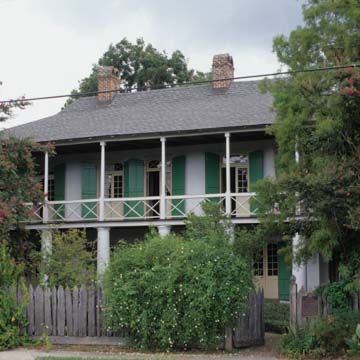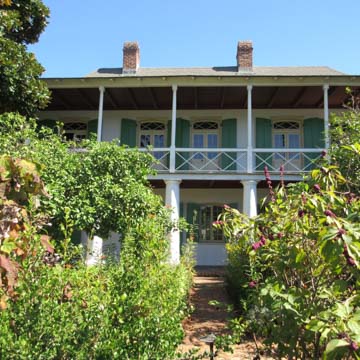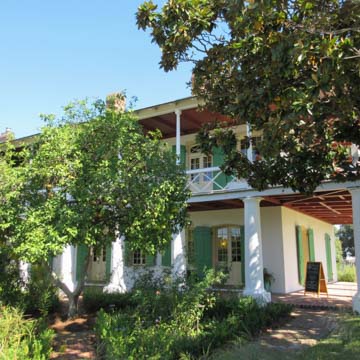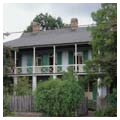Merchant and shipowner Don Bartholemé Bosque, from Palma, Majorca, began construction of this beautiful house and sold it unfinished in 1800. In 1805, Marie Tronquet, the widow of Vincent Rillieux and great-grandmother of Edgar Degas, purchased the residence and Boutté (1754–1808) completed it. The ground floor is constructed of stuccoed brick and the upper of brick-between-posts covered with stucco. Front and side galleries are supported on brick Tuscan columns at ground level and slender wooden colonnettes above. The house has a double-pitched hipped roof. The plan consists of three rooms across the front, without corridors, with a loggia between two smaller cabinets at the rear of the second level. Stairs in the rear loggia link the two floors. An original set of stairs within the side gallery was intended for guests. Some scholars describe this house type as French West Indies because it is similar to contemporary houses on the Caribbean islands; however, others believe that French Canadians brought the type and style with them before 1700. In 1810, commission merchant James (Jacques) Pitot, who came to New Orleans from Saint-Domingue in 1796 after the slave uprisings, purchased the house for his family. He later became New Orleans’s first elected mayor. Behind the house Pitot had two cabins for his six enslaved workers, a kitchen, a barn, stables, privies, a vegetable garden, and farm animals. In 1904, Mother Francis Cabrini purchased the house and used it as a convent, then rented it out. In 1964, when the sisters planned to demolish the building in order to build a school on the property, the Louisiana Landmarks Society acquired and moved the timber-framed structure two hundred feet from its original location, now occupied by the neighboring school. Koch and Wilson, Architects, were hired to restore it to the Pitot time period, and it was opened as a house museum in 1972. Although none of the dependency buildings survive, garden areas have been developed over time, recently (2006–2007, Lake Douglas, landscape architect) with native plants, flowering shrubs, herbs, and vegetables representative of local nineteenth-century gardens.
Nearby at 1300 Moss Street is a similar house, known as the Spanish Custom House, built after 1807 by Robert Alexander for Captain Elie Beauregard. That residence probably acquired its nickname during the Spanish era, when it was the home of Spanish custom officer Luis Blanc. This house, which also features a double-height living space from the early twentieth century, was recently restored by Waggonner and Ball Architects.











